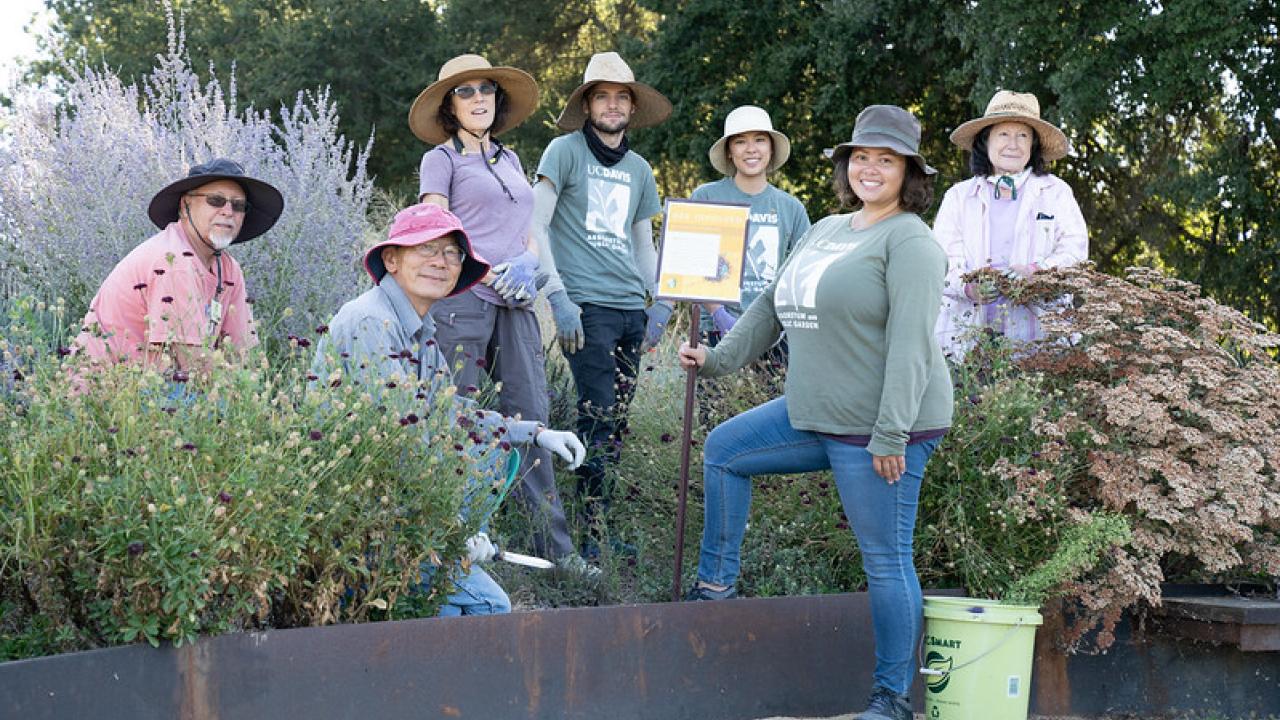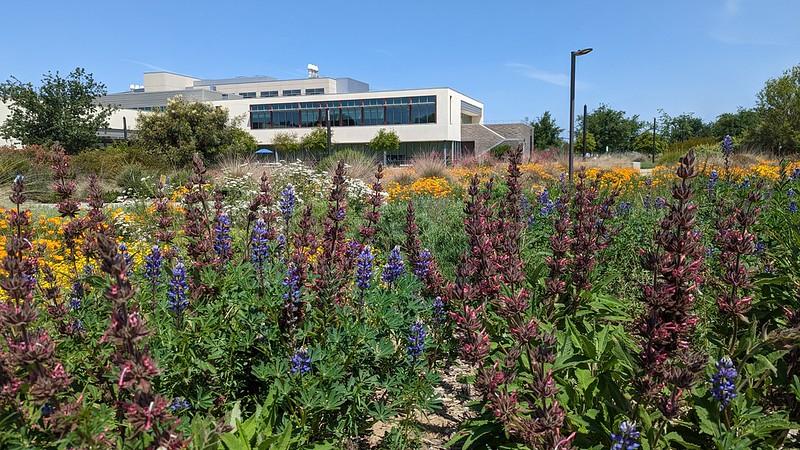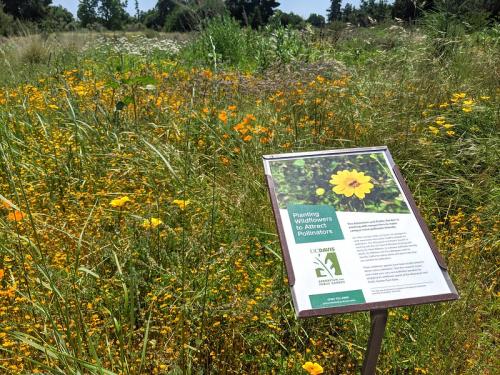
‘Pollinator Squad’ aims to promote biodiversity and climate-ready landscapes at UC Davis
Originally published in the California Aggie, by: Lynn Chen — features@theaggie.org
Amidst the Anthropocene epoch, a geological time period in which humans have substantially impacted Earth’s climate and ecosystems, our responsibility to care for and preserve the environment around us is greater than ever.

The “Pollinator Squad,” a volunteer group of 15 members, is doing its part in shouldering such responsibility through work done in the UC Davis Arboretum as part of the UC Davis GATEways Project (Gardens, Arts, and the Environment). This project is a master planning framework that focuses on improving the Arboretum and the Public Garden for the campus.
Every Thursday, the volunteers meet to develop and manage the Habitat Garden. This includes the meadow basin, the bioswale in the meadow basin, the Hummingbird Garden and the Insect Pollinator Garden. By planting, weeding, pruning and mulching the Habitat Garden demonstration areas, the team achieves their primary goals of supporting local biodiversity and promoting climate-ready landscapes for the future.
For instance, the Pollinator Squad has been growing and maintaining flowering plants that are pollinator-friendly to bees, hoverflies, hummingbirds and other important pollinating species in the gardens. Stray logs and bits of natural wood pieces are left purposefully in the gardens to provide habitat for pollinators like carpenter bees.
According to Rachel Davis, GATEway’s Horticulturist for the UC Davis Arboretum and Public Garden as well as leader of the Pollinator Squad, the volunteers get “really trained up” on how to care for these types of plants.
Davis also said that the team makes sure there are flowering plants for pollinators in the garden year-round.
“We are also trying to lean into the new Climate-Ready Gardening Initiative,” Davis said. “We’re expanding from just pollinators to really thinking about habitat for all the local biodiversity in the Sacramento Valley region [by] trying out new plants.”
Davis explained that this initiative is an innovative living landscape adaptation plan by UC Davis to prepare the campus for factors related to climate change.
The Arboretum has always been a drought-tolerant natural space, as it features plants from all over the world that suit the Mediterranean climate specifically.
However, as part of the Climate-Ready Gardening Initiative, Davis has been working with UC Davis researchers to model what the climate will be like by the year 2100. Then, they use that information to test out new plants in the Arboretum that are suitable for the future climate.
“The Davis area might be like Barstow, California or Tucson, Arizona by the year 2100 as far as the high heat and longer heat waves that we’ve predicted,” Davis said. Using this research, the Pollinator Squad has been testing out plants from the Southwest U.S. in the Habitat Gardens.
The volunteers help test trials primarily by maintaining and collecting data on the new plants.
Besides creating a biodiverse, climate-ready landscape in the Arboretum, the Pollinator Squad is also contributing to raising awareness and educating the public on the importance of its goals.
For example, as part of the Climate-Ready Gardening Initiative, the Squad is participating in a larger pilot project that will be unveiled at the Arboretum between 2023 and 2024.
The initiative will be partnering with the United States Botanic Garden in Washington D.C. to promote climate-ready gardening for a Plants and Climate Change education cohort.
“In [the] fall, we are going to be having a climate-ready gardening outreach training with undergraduate students and master gardeners,” Davis said. “Before the spring plant sales, there will also be a public program of three or four lecture series.” By spring 2024, an online climate-ready gardening tool kit will also be available.
“The Pollinator Squad will be very much helping us ready the garden for these demonstrations and testing out a little bit more of the [plants in the Habitat Gardens],” Davis said.
Additionally, by actively tending to and enriching the Habitat Gardens, the Pollinator Squad is raising awareness for its work. Nurturing a beautiful natural space that people can interact with leads to more appreciation for efforts in environmental conservation, according to Davis.
“I worked a lot at UC Santa Barbara and [for the] National Park Service […] A lot of the areas I worked on weren’t really accessible by the public,” Davis said, “And so people weren’t as knowledgeable or excited about works done by restoration projects.”
“I realized what we needed was for people to care so we can conserve and steward this land more properly,” Davis continued.

Joan Quinn, a Pollinator Squad team member of seven years, described how the group also worked on putting in more signs for their garden’s flowers in order to help passersby identify pollinator-friendly plants.
“We do have people who stop us while we’re working to ask, ‘What’s the plant?’” Quinn said. “I think it’s really important for people to realize we need [pollinators] and we need to provide an environment for them to live.”
Furthermore, volunteers themselves — many who do not have any plant-related backgrounds — have come to learn and appreciate biodiversity and the importance of pollinators as well.
Quinn, a retired AT&T employee, has integrated some of what she has gleaned as a volunteer into her own garden as well.
“I’ve learned a lot about particularly pollinators and how important it is that we plant plants for the hummingbirds, bees and butterflies,” said Quinn. “So, I did incorporate [what I’ve learned] into my home garden [by] trying to buy plants that are pollinator friendly.”
However, it is no easy task to improve and care for the Habitat Gardens. The volunteers weed all the invasive plants by hand, as herbicides harm biodiversity. Certain flowers are deadheaded one by one. Overgrown shrubs and tree branches are cleared from pathways for pedestrians and cyclists, while garden beds are mulched to increase water efficiency and keep weeds down.
Even though work under the Pollinator Squad may seem tedious and monotonous to an outsider, its members have cited it as a rewarding experience.
William Mitchell is a fisheries biologist who retired last year from working in salmon and steelhead conservation programs. Wanting to stay involved in environmental stewardship and supporting biodiversity, he joined his current band of volunteers six to seven months ago.
“I love to learn,” Mitchell said. “I still love fisheries biology and aquatic ecology, but now I’m learning a lot more that I didn’t get a chance to learn about the terrestrial ecosystems […] in California.”
Mitchell described how he feels rewarded for all the knowledge he’s gained and the natural wilderness he’s experienced volunteering with the Pollinator Squad.
“I’ve been really benefiting from my relationships with the people [in the Pollinator Squad] because they know a lot more than I do,” Mitchell said. “Learning about the relationships between the pollinators and the plants, that’s fascinating to me because that’s kind of what I studied with fish — the relationships between fish and their habitat.”
Mitchell isn’t afraid to tackle the harder tasks as part of the Pollinator Squad.
“I love the meadow area [of the Habitat Gardens],” he stated. “Instead of typical, more manicured plants along the pathways, it’s more of a wild setting. I’m one of the only ones who likes to work in there, because you get in there, and it’s just, everything’s growing everywhere.”
Like Mitchell, Quinn also enjoys working with the Pollinator Squad.
“It is fun socially,” she said. “We only see each other once a week, […] but we keep up with each other’s lives.”
Quinn spoke on the most rewarding aspect of being in the Pollinator Squad.
“We’ll start in an area that’s a real mess and then look at it after the end of the session and go ‘Wow, look what we did,’” he said. “It’s the feeling of accomplishing something and contributing to the Arboretum.”
